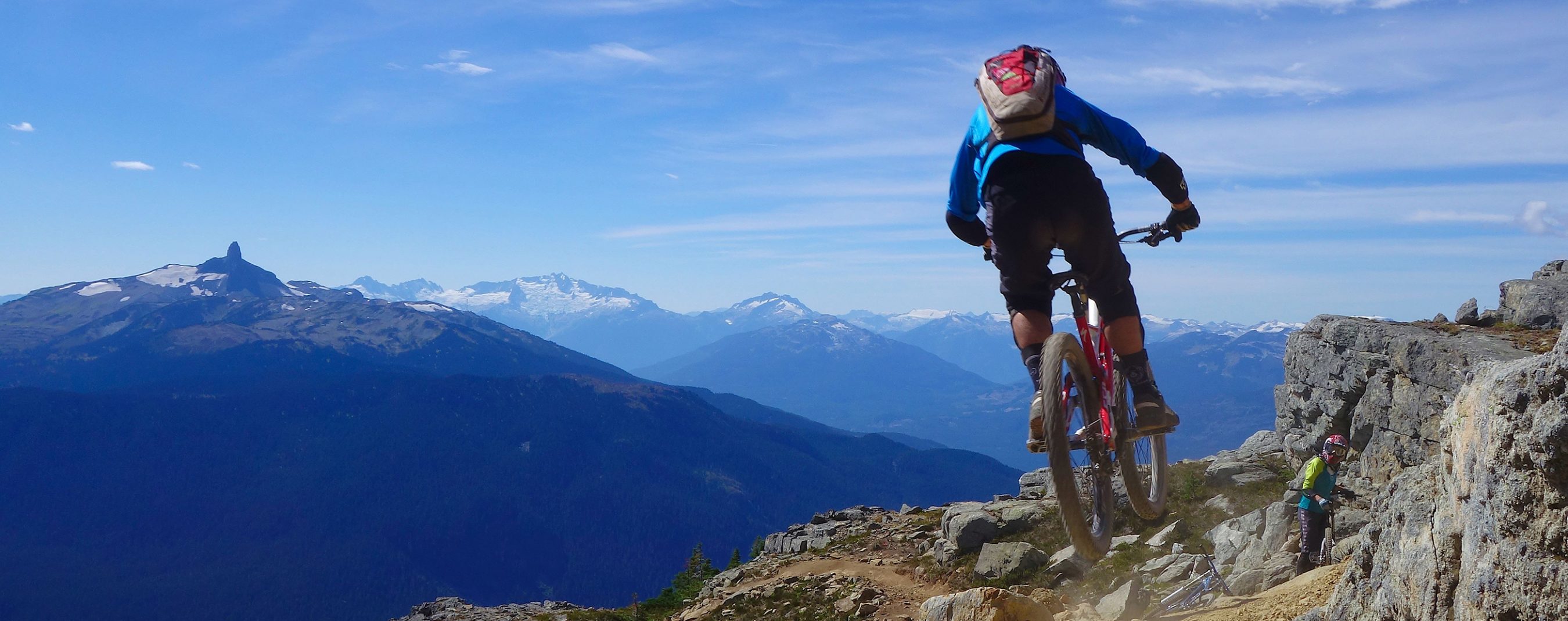Nestled in the heart of British Columbia’s Coast Mountains, Whistler’s natural beauty and endless recreation opportunities draw visitors year-round. Just two hours north of Vancouver, Whistler is home to one of the largest ski resorts in North America, a world-famous bike park and a charming, European-style mountain village filled with some of Canada’s top restaurants. The lively, international community makes Whistler an inviting place to spend a weekend, a month or even a season if you can manage it.
Whether you’re a seasoned Whistler veteran or looking to explore the Coast Mountains for the first time, this year-round guide will help you navigate the variety, including:
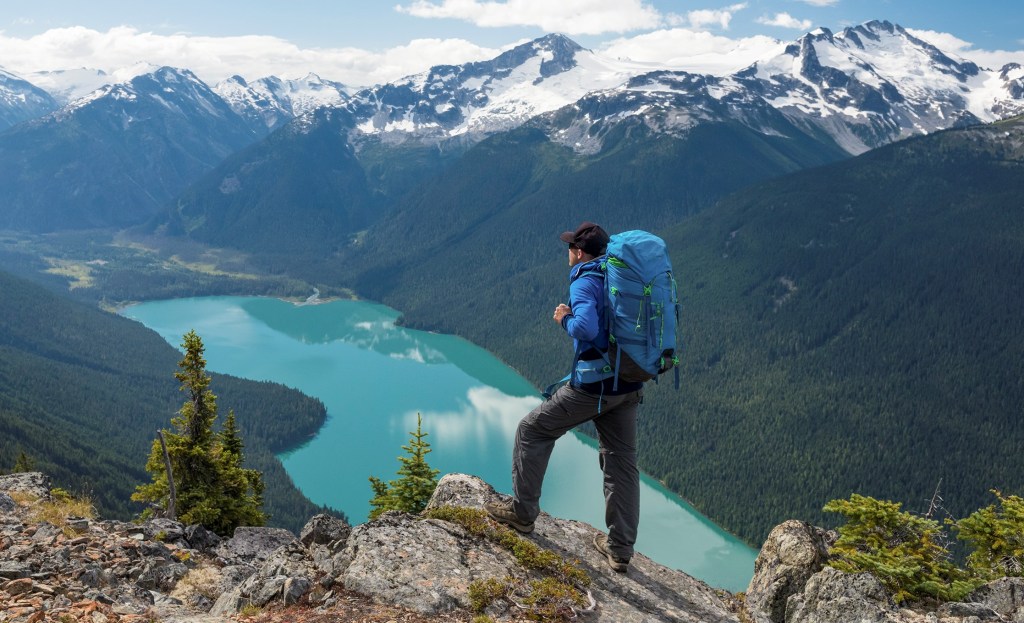
A backpacker enjoys a grand vista deep in the Coast Mountain wilderness.
“It’s the perfect combination of outdoor recreation, a hopping town life, and stunning alpine scenery,” says Heather Gyselman, REI Adventures program manager for North America. “The atmosphere is reminiscent of a European alpine village—something that’s not common to come by in North America.”
Why Visit Whistler?
World-class skiing and snowboarding, a lifetime of hiking trails, pristine alpine lakes and loamy singletrack draw all types of adventurers to Whistler. Adrenaline junkies flock to the gravity-fed downhill trails and near-vertical couloirs, while families enjoy scenic hikes, sun-soaked afternoons on Alta Lake, wide-open groomed runs, or thrilling zip-line tours through dense old-growth forests.
Towering over 7,000 feet in the sky, Whistler and Blackcomb mountains sit side by side, connected by the massive Peak 2 Peak Gondola that makes it possible to explore both ski areas in one day if you choose. Many visitors use the resort as a jump-off point for longer hikes, riding the gondola up to access the remote turquoise lakes and ancient glaciers that fill neighboring Garibaldi Provincial Park.
Tons of festivals, incredible food and a welcoming local culture make it easy to fill your evenings when the lifts close. If you’re coming from the United States, the dollar has stayed strong in Canada in recent years, making it a great excuse to treat yourself a little more than usual.
Enjoy a Caesar (the flavorful Canadian version of a Bloody Mary) on the deck of one of the many patios that overlook the Village Stroll, or reward yourself after a long hike with a greasy order of poutine. Canadians really do live up to their friendly reputation, so don’t be afraid to strike up a conversation in the lift line or along the trail—chances are you’ll get some invaluable local insight or maybe even walk away with a dinner invitation.
Top Sites in Whistler
Soaring more than 1,400 feet above Fitzsimmons Creek at the highest point, the Peak 2 Peak Gondola transports skiers, snowboarders, hikers and sightseers between Whistler and Blackcomb mountains in just 11 minutes. The scenic ride offers unparalleled views of giant peaks and glaciers in the Spearhead and Fitzsimmons ranges all the way down the lush forested valley to the village below.
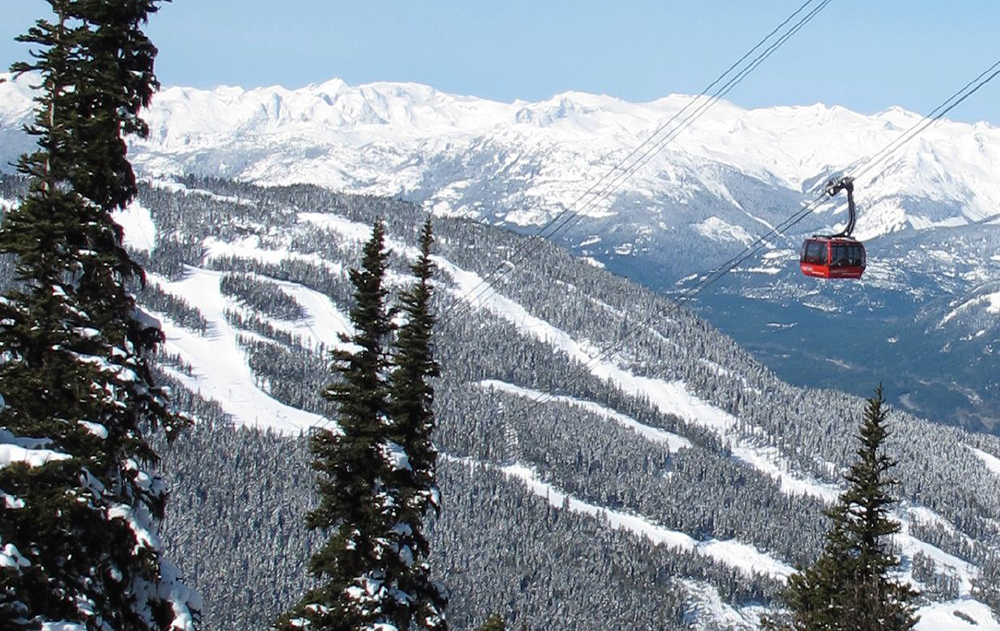
At over 8,000 acres of terrain, Whistler Blackcomb is truly enormous. What connects it all? The Peak 2 Peak Gondola. (Photo Credit: Tim Gillin under CC BY 2.0)
When it was finished in 2008, the Peak 2 Peak broke the Guinness World Record for the longest unsupported span between cable car towers as well as the highest cable car above the ground. Tip: Even if you’re not planning to hike or ski, it’s worth taking the scenic ride across—wait a few extra minutes when you’re boarding and wait for one of the two silver gondolas with a glass bottom.
Black Tusk
Easily the most recognizable peak in the Whistler area, the Black Tusk is a massive spire of dark volcanic rock that rises 7,608 feet above Garibaldi Provincial Park. Its striking silhouette catches the eyes of many visitors from the top of the Whistler Mountain Peak Chair and along the Sea to Sky Highway driving up from Vancouver. Although many are content to snap a few photos from a distance, a strenuous 16-mile out-and-back leads to the top, rewarding you with an incredible view of Garibaldi Lake. It’s a popular trail for climbers, with a Class 3 scramble up to the false summit, followed by an exposed section of Class 5 rock to the true summit 10 feet above.
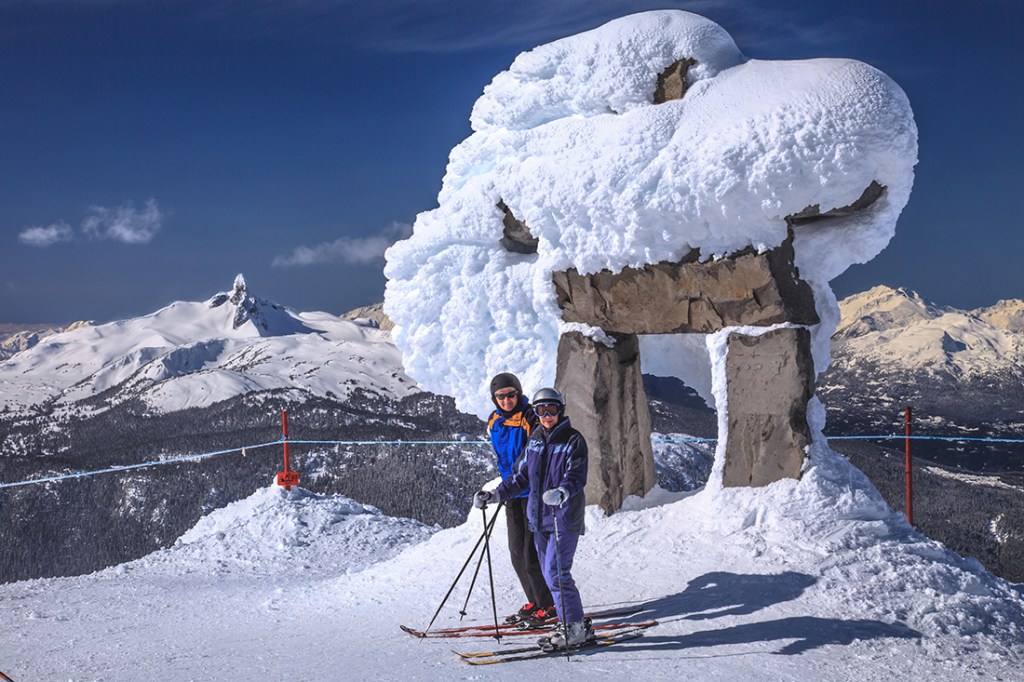
Skiers pose next to a well-frosted inukshuk statue on the summit of Whistler Mountain—the Black Tusk rising in the distance. (Photo Credit: Murray Foubister under CC BY-SA 2.0)
Whistler Sliding Center
If you’ve ever wondered what it’s like to fly headfirst going 60 mph down a sliding track, you’re in luck. Built for the 2010 Winter Olympics, the Whistler Sliding Center on Blackcomb Mountain is a world-class bobsleigh, skeleton and luge track with public tours available in the winter. Visitors without prior experience can hop on an adrenaline-fueled four-person bobsled (steered by a professional pilot), clocking speeds of over 70 mph and experiencing up to four G’s of force. If you want to fly solo, you can take a two-hour instructional class before flying down part of the skeleton track, rattling up to 60 mph headfirst around six icy corners. Public sliding is available December through the end of March, but the center is open year-round to visitors who want to explore the Olympic site.
Rainbow Park, Alta Lake
Less than two miles from the Village Stroll, Rainbow Park makes a fantastic spot to unwind after a long day of hiking or biking. The long stretch of sandy beach on the northwest corner of Alta Lake is a popular spot for swimming, paddling and picnicking, with a spectacular view of Whistler and Blackcomb mountains. The park is named after the historic Rainbow Lodge, a fishing resort built by some of the Whistler Valley’s first pioneers, Alex and Myrtle Philip, in 1914. The lodge, which burned down in 1977, was the center of the original Alta Lake community and was historically the foundation of tourism in Whistler.
The park is great for families and adults, with shaded picnic tables, bathrooms, beach volleyball courts, a designated dog-friendly area, and kayak, SUP and pedal-boat rentals available in the summer.
The Village Stroll
The friendly, pedestrian-only streets of Whistler Village have an irresistible charm, with beautiful stone pathways inspired by mountain towns in the Alps. In the summer and winter, there’s always a lively buzz of activity and excitement along the stroll—the patios of the many cafes and restaurants are a great spot to people-watch while enjoying an afternoon drink and some live music. Stop into one of the many rental shops with any equipment questions or needs, or stop by the ice rink in the winter for a family-friendly evening activity.
Top Outdoor Things To Do in Whistler
1. Hiking
You could spend decades hiking around Whistler and still feel like there’s more to explore. Dozens of trails are easily accessible from the top of Whistler and Blackcomb mountains, and expansive Garibaldi Provincial Park is packed with pristine alpine lakes, rocky traverses, ancient glaciers and incredible views of some of the highest peaks in the Coast Mountains. “It’s amazing how quickly you can be transported so high into the alpine,” Gyselman says of the lift-accessed trails at the resort. “And the alpenglow at the end of each day is truly magical.”

A hiker sips fresh glacial water in the Whistler alpine.
Harmony Lake Loop
An easy 1.2-mile loop from the top of the Whistler Village Gondola, Harmony Lake is a great place to warm up your legs (and your lungs) at the beginning of your trip. The trail descends to the lake from the Roundhouse Lodge, with a few steep sections that open up to a spectacular view of Blackcomb Mountain and the opportunity to dip your toes in the cool glacial water of Harmony Lake.
Overlord Trail to Decker/Lakeside Loops
The Overlord Trail is Blackcomb’s signature hike, traversing the mountain through colorful meadows to access the Decker and Lakeside loop trails. Lakeside Loop is a moderate hike that skirts Blackcomb Lake, and is one of the best spots on the mountain to see wildflowers in bloom. For a more difficult route, Decker Loop is steep, but rewarding, with a scrambly boulder field that bumps right up to the boundary of Garibaldi Provincial Park. Take in up-close views of the ancient Overlord Glacier before stopping for a snack at Decker Tarn, a glacial-fed alpine lake.
High Note Trail
If for some reason you only have time for one hike while you’re in Whistler, make it the High Note. It won’t take long to figure out why this trail is one of Whistler’s most iconic hikes—sweeping views of Cheakamus Lake, the Black Tusk and the Overlord Glacier keep your eyes wide open as you wrap around the backside of Whistler Mountain.
Take the Peak Chair to the 7,160-foot Top of the World Summit, then follow the rugged 5.8-mile trail all the way back to the Roundhouse Lodge. The path is steep and rocky at times, so hiking poles are a good option if you aren’t as comfortable on loose terrain.
Wedgemount Lake Trail
One of the most difficult hikes in Garibaldi Provincial Park, the Wedgemount Lake Trail is well-worth the extra effort. At just under 10 miles round-trip, the relentless 4,000-foot climb is not for the faint of heart. A steep, exposed scramble up the final section drops you in front of a jaw-dropping glacial lake, with Mount Cook, Mount Weart, Wedge Mountain, Parkhurst Mountain and Rethel Mountain towering above. If you’re willing to haul your gear, 20 tent platforms are available on a first-come, first-served basis with a small camping fee paid at the trailhead. The trailhead for the Wedgemount Lake Trail is a 10-minute drive north of Whistler along Highway 99.
2. Mountain Biking
Whistler is a haven for two-wheeled exploration, with challenging cross-country climbs, an adrenaline-fueled downhill park and tons of paved paths to get you wherever you need to go. Because of the popularity, Gyselman says that the trails are incredibly well-built and maintained.
“Visitors always come back raving about how well-maintained the trails are,” she says. “And the variety of trails are great for progression, so it’s not uncommon to finish off your trip riding trails you never thought you’d be able to.”
The Zappa Trails at Lost Lake are a great way to get your bike legs under you if you’re planning to ride for a few days. The large network of intermediate and beginner cross-country trails are just a quick pedal from Whistler Village, with classic Northwest features under a dense green canopy. Wooden bridges, rock rolls and tangled root sections keep things interesting, while smooth, flowy sections are perfect for kids and newer riders. The short trails are easy to navigate, and it’s easy to link up different loops depending on rider level.
Comfortably Numb, in Whistler North, is one of the International Mountain Bike Association’s featured rides, a step up from Lost Lake and a good challenge for intermediate riders.
The 14-mile trail is typically ridden north-south and features a steady 2,500-foot climb, a fast, flowy descent, and stunning Pacific Northwest scenery.
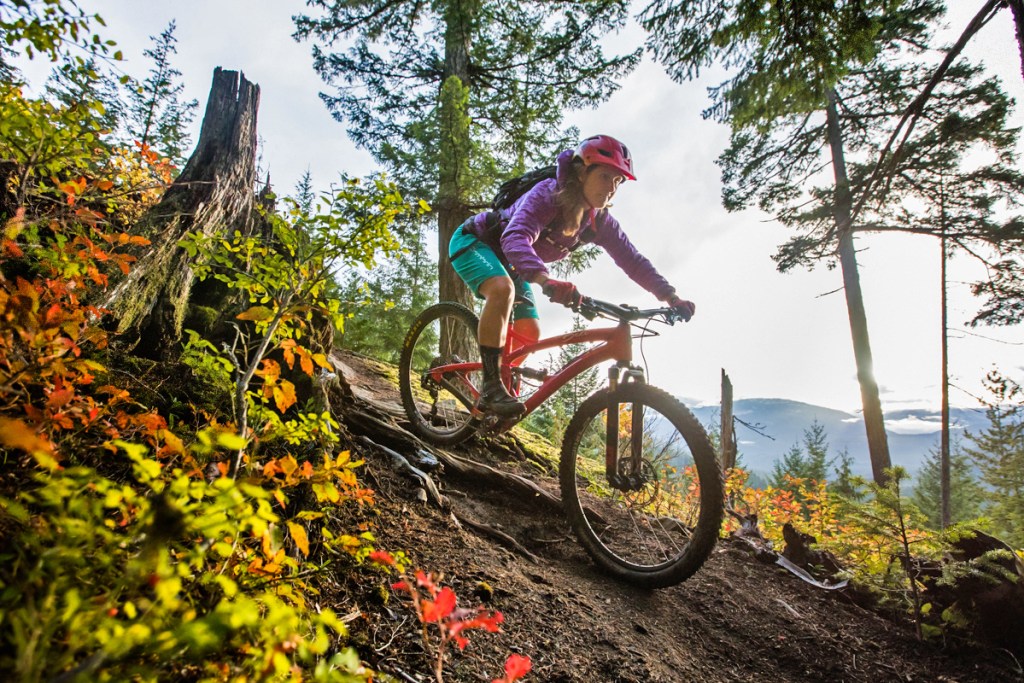
A mountain biker sessions the world-class Whistler Bike Park.
The Whistler Mountain Bike Park is a surefire place to get your blood pumping, with over 50 miles of singletrack and 4,900 feet of lift-accessed descent.
Four distinct zones on Whistler Mountain offer options for riders of all levels, with intermediate flow trails, jump lines, berms and techy root sections. The Fitzsimmons Chair has the most beginner-friendly terrain, while a ride up Garbanzo or down to the Creekside Gondola are longer and more committing. The Top of the World Trail is aptly named—and is for advanced riders only—descending 5,000 feet through rocky alpine terrain down to the forested valley floor.
3. Skiing and Snowboarding
Whistler Blackcomb Resort
With over 8,000 acres of skiable terrain, 37 lifts, and more than a mile of vertical relief, Whistler Blackcomb is truly a resort powerhouse. Technical chutes, wide-open groomers, perfectly spaced glades and steep faces provide a lifetime of terrain for skiers and riders of all levels.
From the top of the Whistler Gondola, the Emerald Express Chair has plenty of beginner and intermediate terrain, with options to duck into the trees for skiers and riders who want a little extra challenge. If the weather’s clear, ride the Peak Express to the Top of the World Summit and enjoy some of Whistler’s best high-alpine terrain. Try your hand at the iconic Peak 2 Creek Run, a 5,000-foot descent over seven miles from the top of the Peak Express all the way down to Creekside Village. Bonus points if you can make it to the bottom without stopping.
On the Blackcomb side, the scenic 7th Heaven Express is a favorite among families and experts alike, with a plethora of beginner, intermediate and expert terrain above treeline. Solar Coaster is a great option for cruising, with long rolling groomers as well as access to Blackcomb’s Terrain Park. From the top of 7th Heaven you can access Blackcomb’s legendary Couloir Extreme, a 2,500-foot chute that helped give Whistler its reputation for steep skiing. Even if you don’t plan to ski the couloir, it’s worth skiing by on the cat track to take a peek into the near-vertical entrance.
Heli-Skiing
If the big-mountain terrain and remote glaciers surrounding Whistler Blackcomb are calling your name, Whistler Heli-Skiing offers single and multiday packages for intermediate to advanced skiers. While there are definitely opportunities to challenge yourself on death-defying steeps, plenty of the terrain in the Garibaldi Range features low-angle glades and wide-open bowls. With almost half a million acres of tenured land and 475 runs, the opportunities for fresh tracks in the Garibaldi Range are endless.
Backcountry Skiing/Riding
If you’re looking to earn a few turns, there are plenty of opportunities for backcountry skiing surrounding the resort. Whistler offers a backcountry lift ticket (with proof of proper equipment) that allows you a single trip up the mountain to access the higher terrain from resort gates. Oboe Basin behind the Flute Bowl on Whistler Mountain is a great option for a day tour, as well as the many peaks behind the Blackcomb Glacier.
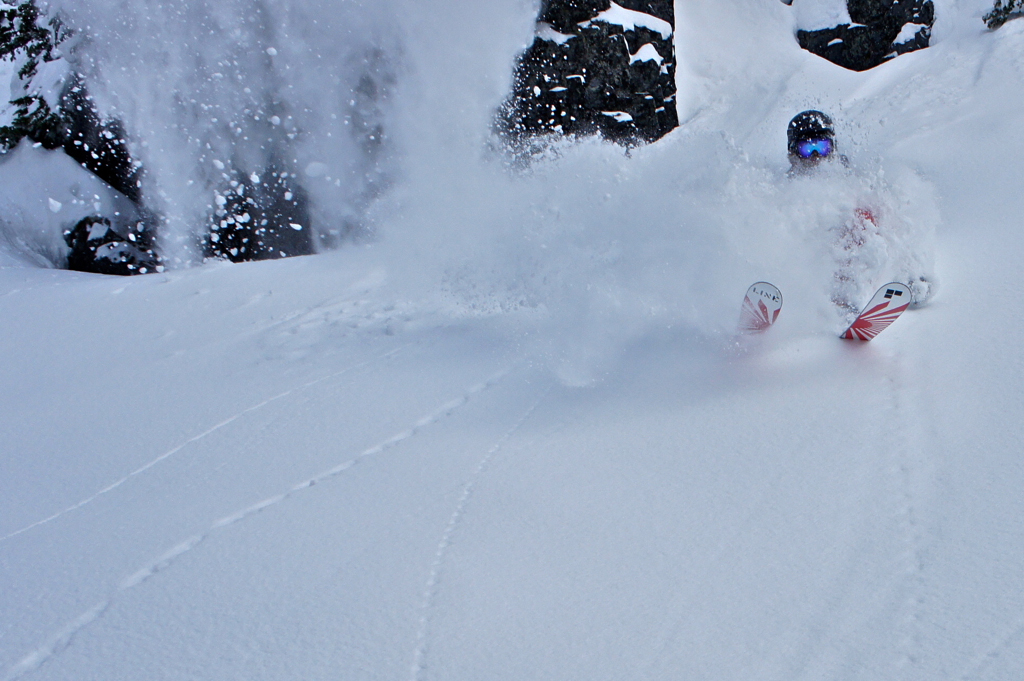
A skier reaps the powder rewards of the Whistler backcountry. (Photo Credit: Nihiriju Sills under CC BY 2.0)
If you really want to challenge yourself, the Spearhead Traverse is a challenging multiday ski tour that traverses from Blackcomb to Whistler Mountain, crossing 13 different glaciers over the 25-mile route. Competent intermediates will traverse the Spearhead in three or four days, camping along the way, while elite ski mountaineers have been known to traverse the marathon route in a single day.
Backcountry skiing is easy to access from Whistler, so be sure to have the proper training and safety equipment if you’re thinking about heading out.
4. Rock Climbing
Although there are some opportunities for rock climbing in the Whistler area, Squamish, 45 minutes south of Whistler Village, is considered to have some of the best granite in the world and is where most climbers head. As you drive up to Whistler along the Sea to Sky Highway, it’s impossible to miss the Stawamus Chief, a massive granite dome that looms large over the town of Squamish.
Routes on The Chief are easy to access, with crags just a five-minute walk from downtown. The Grand Wall is a Squamish classic, a challenging trad route typically done in nine pitches with splitter cracks, endurance-testing laybacks and a bouldery crux. The Apron has tons of moderate routes, with runout slab, cracks and stellar views of the Coast Range.
Mountain Skills Academy guides day tours in Whistler and Squamish for climbers of all levels and includes all gear and transportation.
5. Zip-Lining and Bungee Jumping
Zip-lining is an exhilarating way to explore Whistler, flying through old-growth forests, over rushing creeks and river valleys, and over bikers, hikers and skiers on the trails below. Ziptrek Ecotours start and end in Whistler Village, zipping through the forest in the Fitzsimmons Valley and Whistler and Blackcomb mountains. Depending on your interests (and how brave you feel), choose between an ecology-based tour, an evening twilight tour or the Sasquatch Tour—a 1.5-mile line that runs from Blackcomb all the way across to Whistler. It’s the longest zip-line in all of Canada or the U.S., rising to more than 600 feet above ground in the most thrilling sections.
If zip-lining isn’t enough of an adrenaline rush, free falling 160 feet toward the roaring Cheakamus River ought to satisfy. Fifteen minutes south of the Village, Whistler Bungee is open year-round and is a great activity to check off your bucket list. Choose from solo or tandem jumps; reservations are required and can be made by phone or in person at the office in the Village.
How to Plan Your Trip
When to Visit
Summer
Endless hiking opportunities and a world-class bike park make summer one of the most popular times to visit Whistler. Temperatures rise to the low 80s in the summer, making it the best time to enjoy a swim in the many alpine lakes. The Village can get pretty busy midsummer, so book your trip well in advance if you’re planning a trip in July or August.
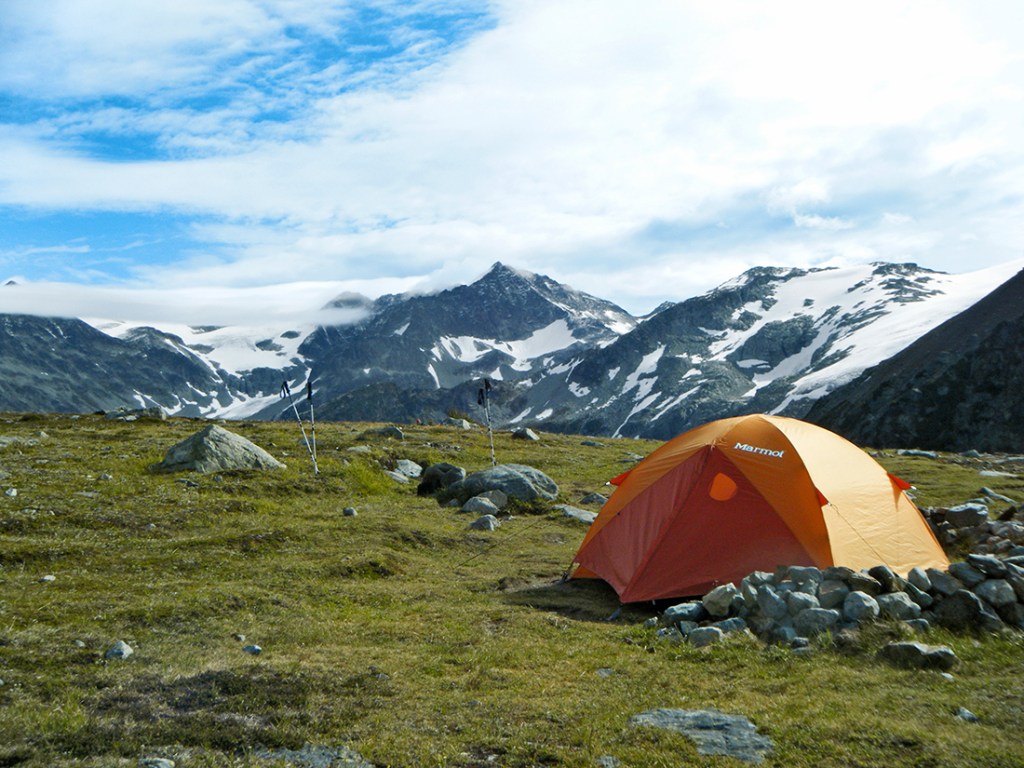
For optimal hiking and backpacking conditions, try the summer and early fall.
Fall
Autumn is the quietest time of the year, though there are still plenty of chances to bike, hike and sometimes even ski in the off-season. Although the weather is significantly less predictable, fall can reward visitors with colorful hikes and perfectly tacky bike trails. One of the first resorts in the area to start spinning lifts, Whistler Mountain usually opens for skiing and snowboarding the weekend before U.S. Thanksgiving.
Winter
With an almost 200-day ski season, Whistler Blackcomb sees a steady stream of visitors all winter long. Although Whistler Village is a magical place to spend the holidays, late January and February tend to have more consistent snowfall and more reasonable lodging options. It often snows down to the valley floor, but it’s not uncommon for the Village to sit above freezing level. The good thing is, with over 5,000 feet of relief, rain down low usually means snow up high.
Spring
Although the winter crowds start to die down in the spring, often the skiing is still just as good in March and lift lines are quite a bit shorter. Spring is a festive time to be in Whistler—the World Ski and Snowboard Festival takes place every April, a famous celebration of winter sports that blends art, music and competitions. GO Fest happens in May, a multisport festival in the Village that celebrates the incredible variety of recreation opportunities Whistler has to offer—ski, bike, golf, paddle—all in one day if you want!
Where to Stay
Whistler has plenty of lodging options to choose from, with hostels, hotels, condos and chalets to fit every traveler’s budget. Staying in the Village makes it easy to get around without a car, with restaurants, cafes, bars and the resort just steps away.
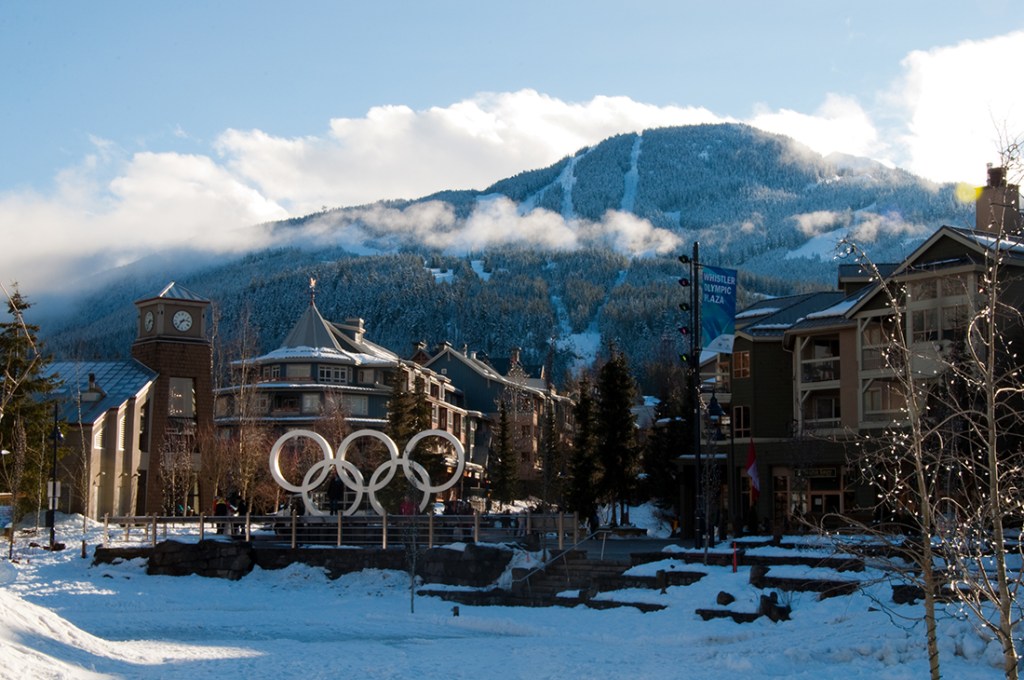
Need a place to stay? Whistler Village can be a convenient, central place to set up basecamp. (Photo Credit: Matthew Grapengieser under CC BY-SA 2.0)
Generally, the closer you are to the base of the Whistler Gondola, the louder it is at night, so staying in the Village can be a great option if you’re looking to be in the center of the action. Otherwise, look for a spot a little ways down the stroll. The Upper Village on the Blackcomb side is much quieter, with luxury hotels as well as slopeside condos under the Wizard Chairlift that are great for families.
Riverside Resort, a few minutes outside the Village, is open year-round, with multiuse campsites and RV spots that have full hookups, coin-operated showers, picnic tables and firepits.
Getting Around
If you’re traveling from within the Northwestern U.S., you’ll need to make your way to Vancouver, B.C. (be sure to check the border wait times). There’s only one road north from Vancouver to Whistler, and it’s pretty quick and straightforward. Those coming from farther away usually opt to fly into Vancouver and then rent a car or take one of the many shuttles that offer an airport transfer.
Once you’re in Whistler, you won’t have much need for a car. Free bus transit makes it easy to get around town and many of the hiking trails can even be accessed by bus in the summer.
